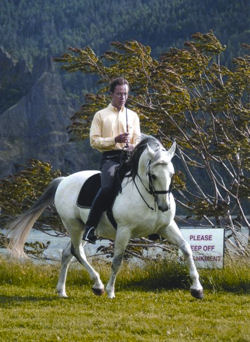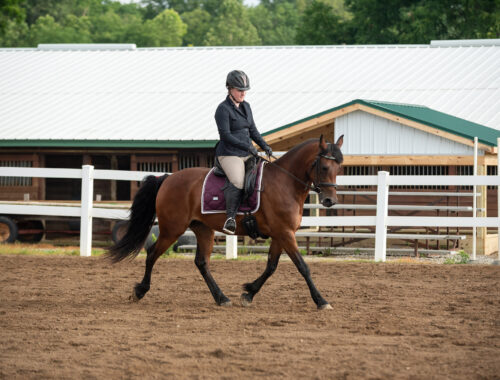Trot Lengthening
Trot Lengthening Defined
A distinct two-beat, diagonal gait where diagonal pairs of legs move forward at the same time, in which the horse demonstrates more elongation in the frame and an increased stride length from that presented at the normal working trot.
How to Execute the Trot Lengthening
- Start in Working Trot, sitting or rising
- When approaching the short side, ask for a more forward trot
- Half halt before reaching the final corner of short side
- At corner, ask for a slight leg yield to the outside
- At “K,” look up towards H and turn horse on to the diagonal
- As soon as horse is completely straight, sink seat bones into the saddle and close calves on the horse’s sides
- Rider should receive the horse’s energy through her hands and maintain a relaxed and balanced body position
- Approximately 3 strides before H, close fingers gently on the reins
- At the corner, half halt again and perform a slight leg yield to re-balance the horse
- The horse should enter the short side in a nice, springing working trot
This exercise can be performed in sitting or rising trot. In order to perform this movement effectively at the sitting trot, the rider must insure that she has a well-developed seat and position. Failure to do so, will result in tension in the horse. If performed in rising trot, use effective driving aids each time the rider sits. The horse should be allowed to reach in front of the vertical and fill up his new frame with increased impulsion. When beginning this movement, the rider should only ask the horse to perform a few strides of trot lengthening. As the horse develops his strength, he will be able to perform this movements for longer periods until he can go the entire length of the diagonal.
Purpose of the Trot Lengthening
As the horse develops strength, he will begin to move more and more “uphill,” thus carrying greater weight on his hindquarters. The trot lengthening is the beginning of the extended trot. The general purpose of trot lengthening is:
- To increase strength in the back, loin and hindquarter
- To develop stamina
- To begin the development of a lighter and more responsive horse
Each of the above is essential to the progression of the dressage horse. As the horse develops his gaits and elasticity, the more able he is to perform the required movements of the upper levels.
Common Errors in Execution
- Horse gets faster instead of lengthening the stride
- Horse falls on the forehand
- Rider becomes tense/stiff, thus causing tension in the horse
- Rider does not allow the horse to go in front of the vertical, in turn limiting the horses ability to reach with his forelegs
- Rider loses focus and inhibits the horse’s ability to stay in a good frame
Author: Dressage Academy
Trot
Trot Variations
You May Also Like

Wednesday Wisdom – What is Connection?
August 13, 2025
Rejuvenate Your Dressage Horse
July 6, 2017
One Comment
Pingback: